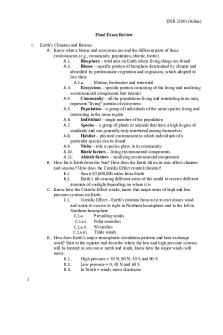A Rough Guide to Spotting Bad Science PDF

| Title | A Rough Guide to Spotting Bad Science |
|---|---|
| Course | Management and Organizational Life |
| Institution | University of Windsor |
| Pages | 1 |
| File Size | 164.9 KB |
| File Type | |
| Total Downloads | 64 |
| Total Views | 171 |
Summary
Download A Rough Guide to Spotting Bad Science PDF
Description
A Rough Guide to
SPOTTING BAD SC Being able to evaluate the evidence behind a scientific claim is important. Being able to reco faults in scientific studies, is equally important. These 12 points will help you separate the sc
1. SENSATIONALISED HEADLINES
Aa
7. UNREPRESENTA In human t are represe the sample as a whole trial may b outcome.
Article headlines are commonly designed to entice viewers into clicking on and reading the article. At times, they can over-simplify the findings of scientific research. At worst, they sensationalise and misrepresent them.
2. MISINTERPRETED RESULTS
8. NO CONTRO
News articles can distort or misinterpret the findings of research for the sake of a good story, whether intentionally or otherwise. If possible, try to read the original research, rather than relying on the article based on it for information.
In clinical t should be c given the s should als general ex be used wh
3. CONFLICTS OF INTEREST
9. NO BLIND
Many companies will employ scientists to carry out and publish research - whilst this doesn’t necessarily invalidate the research, it should be analysed with this in mind. Research can also be misrepresented for personal or financial gain.
To try and not know control gro even resea subjects a blind testin
4. CORRELATION & CAUSATION Be wary of any confusion of correlation and causation. A correlation between variables doesn’t always mean one causes the other. Global warming increased since the 1800s, and pirate numbers decreased, but lack of pirates doesn’t cause global warming.
5. UNSUPPORTED CONCLUSIONS
10. SELECTIVE R
x x
Also known selecting d the conclu ignoring th paper draw of its result
11. UNREPLIC...
Similar Free PDFs

Issue Spotting
- 2 Pages

A Concise Guide to
- 218 Pages

Rough Draft Final - Grade: A
- 3 Pages

K to 12 Curriculum Guide Science
- 203 Pages

A guide to case analysis
- 14 Pages

A Wizard’s Guide to Spells
- 18 Pages

A guide to case analysis
- 14 Pages

A Beginner Guide to Steemit
- 4 Pages
Popular Institutions
- Tinajero National High School - Annex
- Politeknik Caltex Riau
- Yokohama City University
- SGT University
- University of Al-Qadisiyah
- Divine Word College of Vigan
- Techniek College Rotterdam
- Universidade de Santiago
- Universiti Teknologi MARA Cawangan Johor Kampus Pasir Gudang
- Poltekkes Kemenkes Yogyakarta
- Baguio City National High School
- Colegio san marcos
- preparatoria uno
- Centro de Bachillerato Tecnológico Industrial y de Servicios No. 107
- Dalian Maritime University
- Quang Trung Secondary School
- Colegio Tecnológico en Informática
- Corporación Regional de Educación Superior
- Grupo CEDVA
- Dar Al Uloom University
- Centro de Estudios Preuniversitarios de la Universidad Nacional de Ingeniería
- 上智大学
- Aakash International School, Nuna Majara
- San Felipe Neri Catholic School
- Kang Chiao International School - New Taipei City
- Misamis Occidental National High School
- Institución Educativa Escuela Normal Juan Ladrilleros
- Kolehiyo ng Pantukan
- Batanes State College
- Instituto Continental
- Sekolah Menengah Kejuruan Kesehatan Kaltara (Tarakan)
- Colegio de La Inmaculada Concepcion - Cebu







